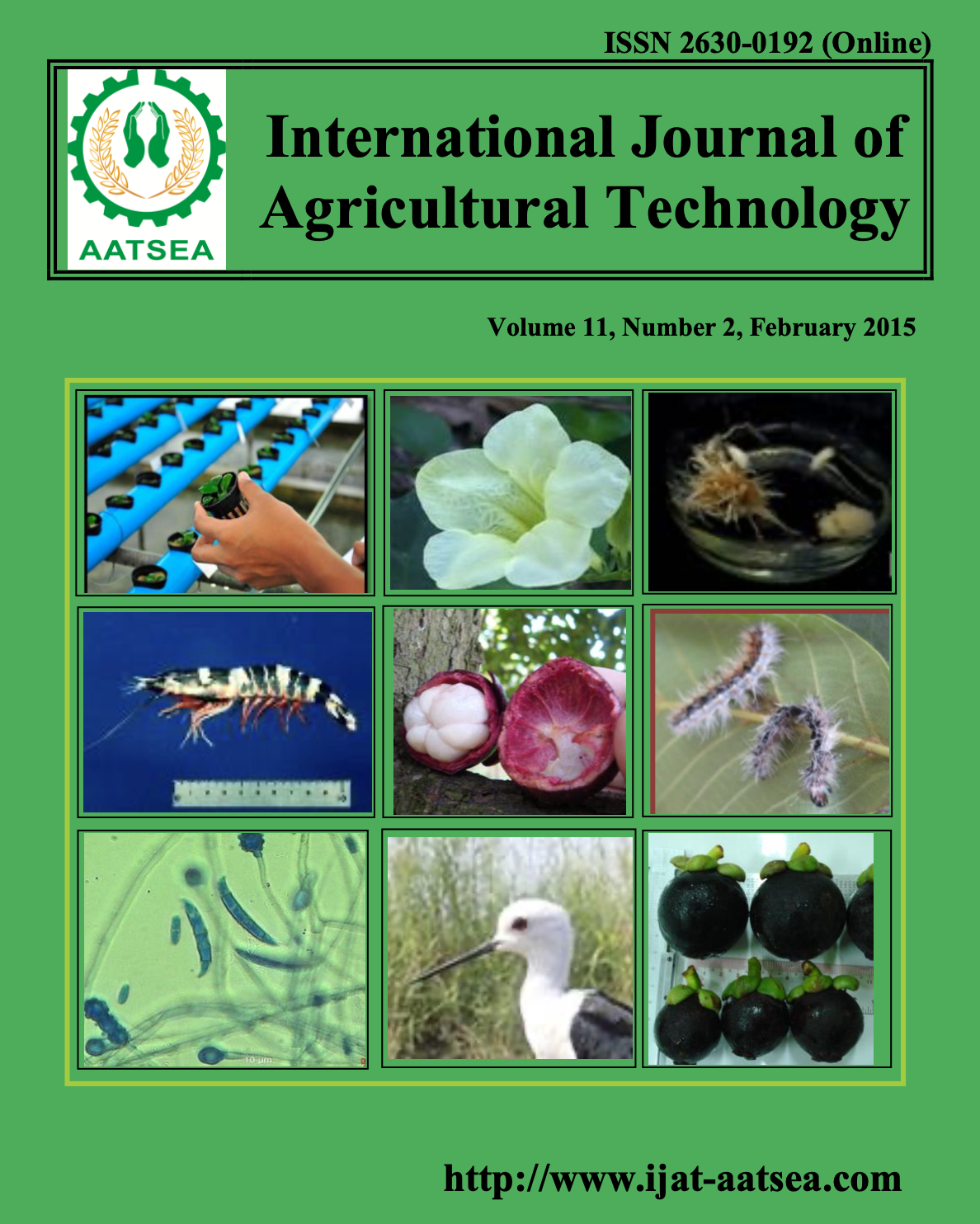Survey of mangosteen clones with distinctive morphology in eastern of Thailand
Main Article Content
Abstract
Article Details

This work is licensed under a Creative Commons Attribution-NonCommercial-NoDerivatives 4.0 International License.
References
Aksornniam, K. (2008). Mangosteen seeds from Indonesia. Journal of Housing Agriculture 3:128-129.
Almeyda, N. and Martin, F. W. (1976). Cultivation of neglected tropical fruits with promise. Part 1. The Mangosteen. ARS-S-155. Agricultural Research Service. U.S. Department of Agriculture.
Corner, E. J. H. (1988). Mangosteen family. In: Wayside Trees of Malaya. Malayan Nature Society. pp. 349-357.
Department of Agriculture Malaysia. (2002). Mangosteen. Retrieved from http://agrolink. moa.my/comoditi/doa/manggis.html.
Downton, J. and W. Grant (1994). Photosynthetic and Growth Responses of Variegated Ornamental Species to Elevated CO2. Australian Journal of Plant Physiology 21:273-279.
Goh, C. J., Lakshmanan, P. and Loh, C. S. (1994). High frequency direct shoot bud regeneration from excised leaves of mangosteen (Garcinia mangostana L.). Plant Science 101:173-180.
Idris, S. and Rukayah, A. (1987). Description of the male mangosteen (Garcinia mangostana L.) discovered in Penisular Malaysia. Malaysian Agricultural Research and Development Institute 15:63-66.
IPGRI (2003). Descriptiors for Mangosteen (Garcinia mangostana). International Plant Genetic Resources Institute, Rome, Italy. 56 pp.
Lim, A. H. (1984). The embryology of Garcinia mangostana L. (Clusiaceae). Gardens Bull Singapore 37:93-103.
Mansyah, E., Muas, I., Jawal, M. A. S. and Sobir, R. P. (2010). Morphological variability of apomictic mangosteen (Garcinia mangostana L.) in Indonesia: morphological evidence of natural populations from Sumatra and Java. Journal of Breeding and Genetics 42:1-8.
Mohamad, B. O. and Abd, R. M. (2006). Mangosteen-Garcinia mangostana. Southampton Center for Underutilised Crops. RPM Print and Design, Chichester, England, UK. 170 pp.
Normah, M. N., Noor-Azza, A. B. and Aliudin, R. (1995). Factors affecting in vitro shoot proliferation and ex vitro establishment of mangosteen. Plant Cell, Tissue Organ Cult 43:291-294.
Ramage, C. M., Sando, L., Peace, C. P., Carroll, B. J. and Drew, R. A. (2004). Genetic diversity revealed in the apomictic fruit species Garcinia mangostana L. (mangosteen). Euphytica 136:1-10.
Richards, A. J. (1986). Agamospermy. In: Plant Breeding Systems, George Allen & Unwin, London. pp. 403-456.
Richards, A. J. (1990). Studies in Garcinia, dioecious tropical forest trees: the origin of the mangosteen (G. mangostana L.). Botanical journal of the Linnean Society 103:301-308.
Rostini, N., Murdaningsih Haeruman, K., Mansyah, E. and Muas, I. (2003). Current Status on Mangosteen Mutation Breeding in Indonesia. In Deutscher Tropentag. pp. 8-10.
Sando, L., Peace, C., Ramage, C., Carrol, B. J. and Drew, R. (2005). Assessment of Genetic Diversity in Austra-Grown Mangosteen (Garcinia mangostana L.) and Its Wild Relatives. Acta Horticulturae 692:143-152.
Surapong, K. (2551) Guide Index harvested fruit. Department of Horticulture, Faculty of Agriculture, Kasetsart University. Retrieved from http://www.doae.go.th/LIBRARY/html/ detail/oi/index.html.
Te-chato, S. and Lim, M. (1999). Plant regeneration of mangosteen via nodular callus formation. Plant cell, tissue organ cult 59:89-93.
Te-chato, S. and Lim, M. (2000). Improvement of mangosteen micropropagation through meristematic nodular callus formation from in vitro-derived leaf explants. Scientia Horticulturae 86:291-298.
Verheij, E. W. M. (1991). Garcinia mangostana L. In: E.W.M. Verheij & R.E. Coronel (Eds.), Eatable Fruits and Nuts. Plant Resources of South East Asia 2:177-181.
Wanthana, B., Iiamtat, C. and Norramatt, P. (2551). Mangosteen: A Guide to 78 of the Mangosteen, Department of Agriculture. Retrieved from http://www.doae.go.th/LIBRARY/html/detail/ magost / index.html.
Wikipedia (2008). Wikipedia, the free encyclopedia. Retrieved from http://en.wikipedia.org/wiki/ Mangosteen.
Yaacob, O. and Tindall, H. D. (1995). Mangosteen Cultivation. FAO Plant Production and Protection Paper. 129 pp.
Yapwattanaphun, C. (2003). Phylogenetic Analysis of Plants in the Genus Garcinia Using ITS Sequence Data and AFLP Analysis. (Thesis Ph.D.). Kasetsart University. 82 pp.


